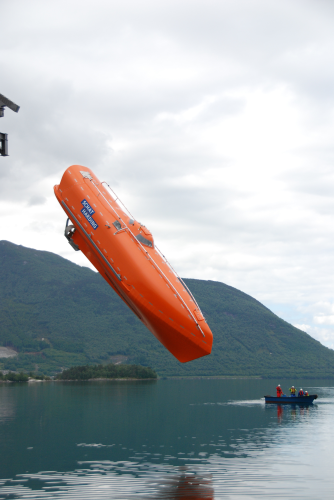
Video: Watch a lifeboat drop test.
This latest drop of 65.1 m was achieved in May 2013 by USH’s updated and improved FF1200 glass fibre reinforced plastic (GRP) lifeboat.
Composite design
As with previous versions, this latest Schat-Harding FF1200 design has glass fibre composite and cored laminate structures for its hull, top section and canopy.
To increase shop floor productivity and improve the impact performance of the lifeboat’s GRP body, Shat-Harding made a number of design modifications. These included increased use of Crystic® Crestomer® structural adhesive from Scott Bader for GRP to GRP bonding.
In the latest FF1200, Crestomer 1152PA is specified for bonding in bulkheads, a proven Crestomer application in Schat-Harding free fall lifeboat hulls for many years, but also for the hull stringers and to join the GRP interliners and canopy to the main hull section.
To achieve the higher production rates needed, Crestomer adhesive is applied using automated bulk dispensing equipment and pneumatic hand guns.
The drop test
This drop test is part of a revised DNV-OS-E406 standard for free fall lifeboats used in the Norwegian offshore sector. As oil rigs and installations get bigger, the industry has recognised the need for improved lifeboat designs which can drop safely and intact from greater heights and in extreme weather sea conditions.
To fully validate the free fall drop test, the FF1200 lifeboat was internally loaded with 7 tonnes to simulate its maximum seated capacity of 70 people in an actual emergency drop evacuation from an offshore installation.
On impact with the surface of the water, the nose section has to withstand an estimated force of 45 tonnes. After impact, the lifeboat fully submerges to a depth of over 10 m before resurfacing.





